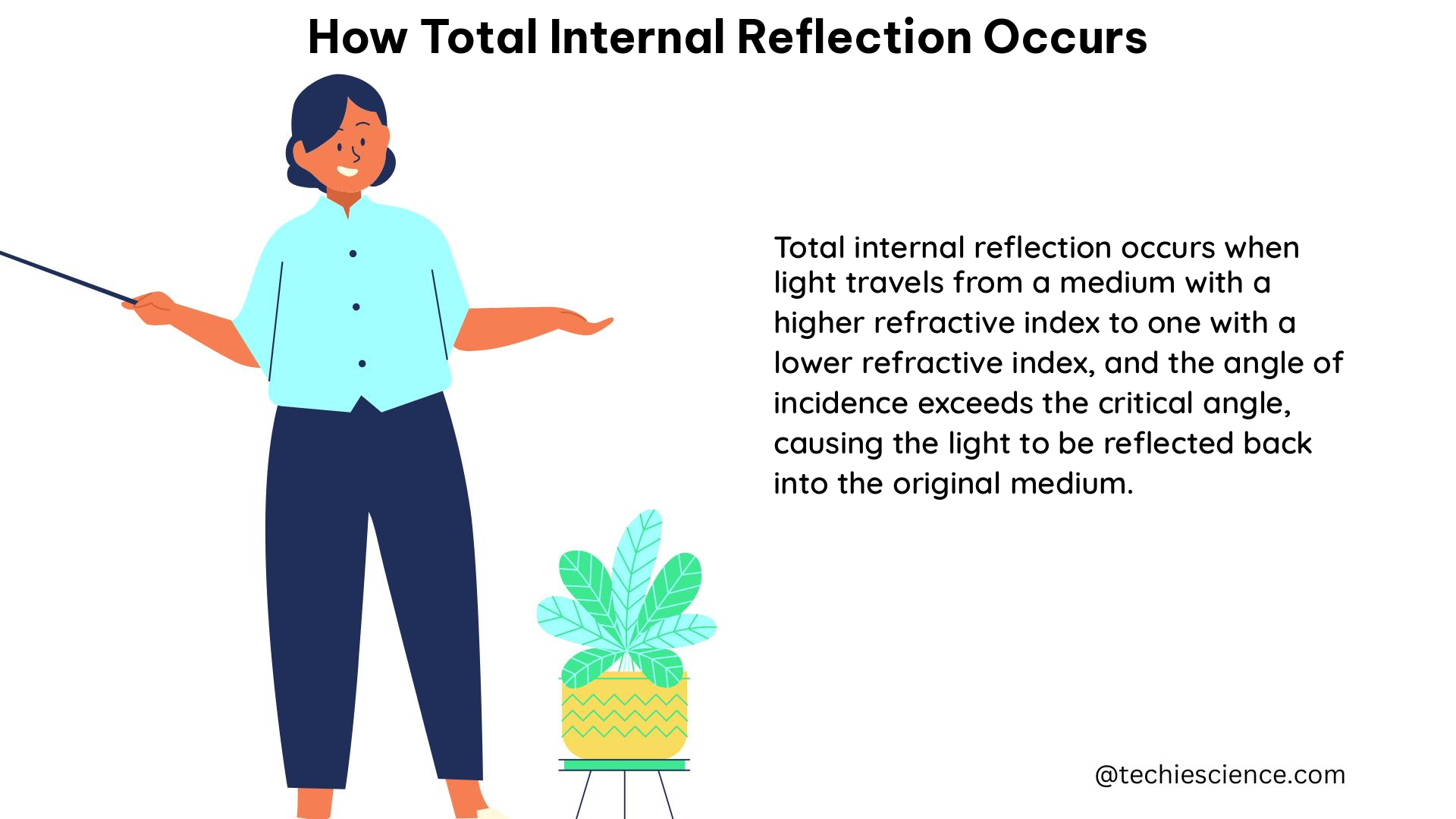Total internal reflection (TIR) is a fundamental optical phenomenon where light is completely reflected back into a denser medium when it reaches the interface with a less dense medium at a specific angle, known as the critical angle. This comprehensive guide delves into the measurable and quantifiable details of how TIR occurs, providing a valuable resource for physics students and enthusiasts.
Critical Angle
The critical angle is the angle of incidence beyond which TIR occurs. It is determined by the refractive indices of the two media involved. The critical angle can be calculated using the following formula:
[θ_c = \sin^{-1}\left(\frac{n_2}{n_1}\right)]
where θ_c is the critical angle, n_1 is the refractive index of the denser medium, and n_2 is the refractive index of the less dense medium.
For example, the critical angle for the water-air boundary is approximately 48.6 degrees, as the refractive index of water is around 1.33 and the refractive index of air is approximately 1.0.
Angle of Incidence

TIR occurs when the angle of incidence is greater than the critical angle. As the angle of incidence increases, the intensity of the refracted ray decreases, and the intensity of the reflected ray increases. At the critical angle, the refracted ray reaches a 90-degree angle, and beyond that, TIR occurs.
Refractive Indices
The refractive indices of the two media play a crucial role in determining the critical angle and the occurrence of TIR. The critical angle is directly related to the ratio of the refractive indices of the two media. For instance, in the case of a diamond-air interface, the critical angle is around 24.4 degrees due to the high refractive index of diamonds (approximately 2.42).
Evanescent Wave
When TIR occurs, a portion of the light penetrates the less dense medium as an evanescent wave. This wave has an exponentially decaying intensity with distance from the interface. The evanescent wave can be used in various applications, such as total internal reflection fluorescence (TIRF) microscopy, where it is used to excite fluorophores in a thin axial region, providing high-resolution fluorescence imaging.
Applications of Total Internal Reflection
TIR has numerous practical applications, including:
- Mirages: TIR creates the illusion of an inverted image due to the temperature contrast between the ground and the air above, leading to total internal reflection of light.
- Diamond Cutting: Skilled craftsmen use TIR to enhance the brilliance of diamonds by shaping them to induce multiple reflections within the gemstone.
- Prisms: TIR is used in prisms to facilitate tasks such as dispersion and image rotation without altering the object’s dimensions.
- Optical Fibers: TIR enables efficient data transmission in optical fibers by minimizing signal loss through repeated internal reflections.
- Total Internal Reflection Fluorescence (TIRF) Microscopy: This technique uses TIR to excite fluorophores in an extremely thin axial region, providing high axial resolution in fluorescence microscopy.
Theoretical Explanation
The physics behind TIR can be explained using Snell’s Law, which describes the refraction of light at the interface of two media:
[n_1 \sin \theta_1 = n_2 \sin \theta_2]
where n_1 and n_2 are the refractive indices of the two media, and θ_1 and θ_2 are the angles of incidence and refraction, respectively.
Numerical Problems
- Critical Angle Calculation: If the refractive indices of two media are 1.5 and 1.0, what is the critical angle for TIR to occur?
Solution: (\sin \theta_c = \frac{n_2}{n_1} = \frac{1.0}{1.5} = 0.67), so (\theta_c = \sin^{-1}(0.67) \approx 42.2^\circ)
- Angle of Incidence: If the critical angle for a water-air boundary is 48.6 degrees, what is the minimum angle of incidence required for TIR to occur?
Solution: The minimum angle of incidence is greater than the critical angle, so it would be at least 48.7 degrees.
Figures and Data Points
- Critical Angle vs. Refractive Indices: A graph showing the relationship between the critical angle and the refractive indices of the two media involved in TIR.
- Angle of Incidence vs. Reflected and Refracted Intensities: A graph illustrating how the intensities of the reflected and refracted rays change as the angle of incidence increases.
Measurements and Values
- Critical Angle for Water-Air Boundary: 48.6 degrees
- Refractive Index of Diamond: approximately 2.42
- Refractive Index of Air: approximately 1.0
- Refractive Index of Water: approximately 1.33
Theorem
Snell’s Law, which describes the refraction of light at the interface of two media, is a fundamental theorem underlying the phenomenon of TIR.
Physics Formula
[n_1 \sin \theta_1 = n_2 \sin \theta_2]
Examples
- Mirage Formation: TIR creates the illusion of an inverted image due to the temperature contrast between the ground and the air above, leading to total internal reflection of light.
- Diamond Cutting: Skilled craftsmen use TIR to enhance the brilliance of diamonds by shaping them to induce multiple reflections within the gemstone.
Reference Links
- https://www.slideshare.net/slideshow/total-internal-reflection-causes-and-effects/267448833
- https://www.shanghai-optics.com/about-us/resources/technical-articles/total-internal-reflection-physics-and-applications/
- https://www.sciencedirect.com/topics/engineering/total-internal-reflection
Hello, I am Deeksha Dinesh, currently pursuing post-graduation in Physics with a specialization in the field of Astrophysics. I like to deliver concepts in a simpler way for the readers.